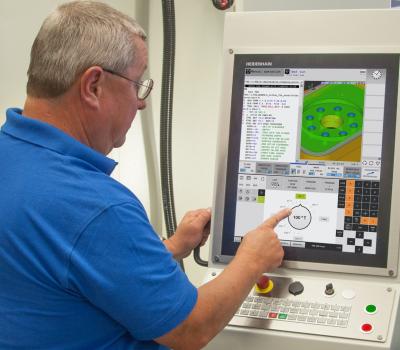
TNC contouring controls from HEIDENHAIN are popular with users thanks to their workshop-oriented operational design and conversational programming. And now, HEIDENHAIN’s compact TNC 620 control combines its advantages of HEIDENHAIN contouring controls with the latest in touchscreen technology.
The TNC 620 control with touch screen is operated by gestures, similar to smartphones or tablet PCs. The operator can navigate quickly and intuitively through long lists, programs, tables and other content by what is known as kinetic scrolling.
A slow, brief swiping movement results in scrolling over a few lines; a longer and quick movement leads to dynamic scrolling over many lines. With a short tap, the user can stop the dynamic scrolling at any time. That makes it possible to easily find, for example, an NC block or a tool in long NC programs or tool tables. In the 3D test mode, zooming in and out as well as moving and rotating objects is particularly helpful. Further, a pop-up keyboard appears for text input.
The new MC 8410 main computer with touch screen technology in the TNC 620 corresponds to the MC 7410 in the prior solution with this functionality.
For the machine builder, a newly designed machine control panel MB 721 with or without Functional Safety is also available with the touchscreen, and features three optional elements that can be assigned to additional keys, key switches or a USB connection and provides potentiometers for feed and spindle speed.
The previous MC 7410 has also been revised and is now available in a new variant. It can be used with the new MB 721 (FS). This enables the OEM to use the MB 721 (FS) as a standard and choose between the MC 8410 with touch screen or the conventional MC 7410 main computer. Both units have an Intel Celeron Ivy Bridge processor, Dual Core with 1.4GHz and 2 GB RAM memory.
On the software side of the TNC 620, the range of standard cycles for milling, drilling and boring machines and optional probing functionality remain compatible with older control versions. The TNC 620 comes standardized as 4-axis control, but can optionally be extended to 5-axis simultaneously operation.
Contact Details
Related Glossary Terms
- boring
boring
Enlarging a hole that already has been drilled or cored. Generally, it is an operation of truing the previously drilled hole with a single-point, lathe-type tool. Boring is essentially internal turning, in that usually a single-point cutting tool forms the internal shape. Some tools are available with two cutting edges to balance cutting forces.
- conversational programming
conversational programming
Method for using plain English to produce G-code file without knowing G-code in order to program CNC machines.
- feed
feed
Rate of change of position of the tool as a whole, relative to the workpiece while cutting.
- gang cutting ( milling)
gang cutting ( milling)
Machining with several cutters mounted on a single arbor, generally for simultaneous cutting.
- milling
milling
Machining operation in which metal or other material is removed by applying power to a rotating cutter. In vertical milling, the cutting tool is mounted vertically on the spindle. In horizontal milling, the cutting tool is mounted horizontally, either directly on the spindle or on an arbor. Horizontal milling is further broken down into conventional milling, where the cutter rotates opposite the direction of feed, or “up” into the workpiece; and climb milling, where the cutter rotates in the direction of feed, or “down” into the workpiece. Milling operations include plane or surface milling, endmilling, facemilling, angle milling, form milling and profiling.
- numerical control ( NC)
numerical control ( NC)
Any controlled equipment that allows an operator to program its movement by entering a series of coded numbers and symbols. See CNC, computer numerical control; DNC, direct numerical control.
- tap
tap
Cylindrical tool that cuts internal threads and has flutes to remove chips and carry tapping fluid to the point of cut. Normally used on a drill press or tapping machine but also may be operated manually. See tapping.

